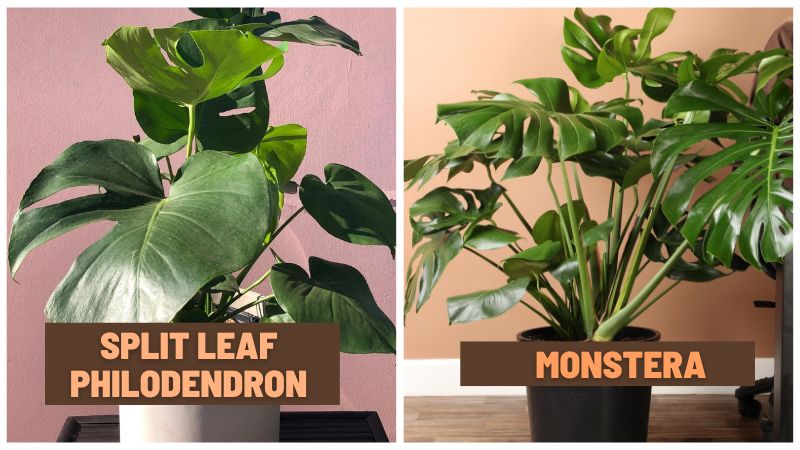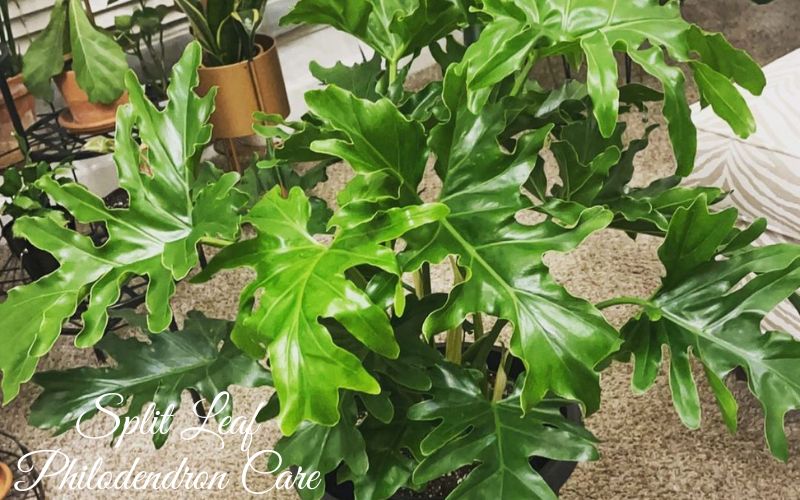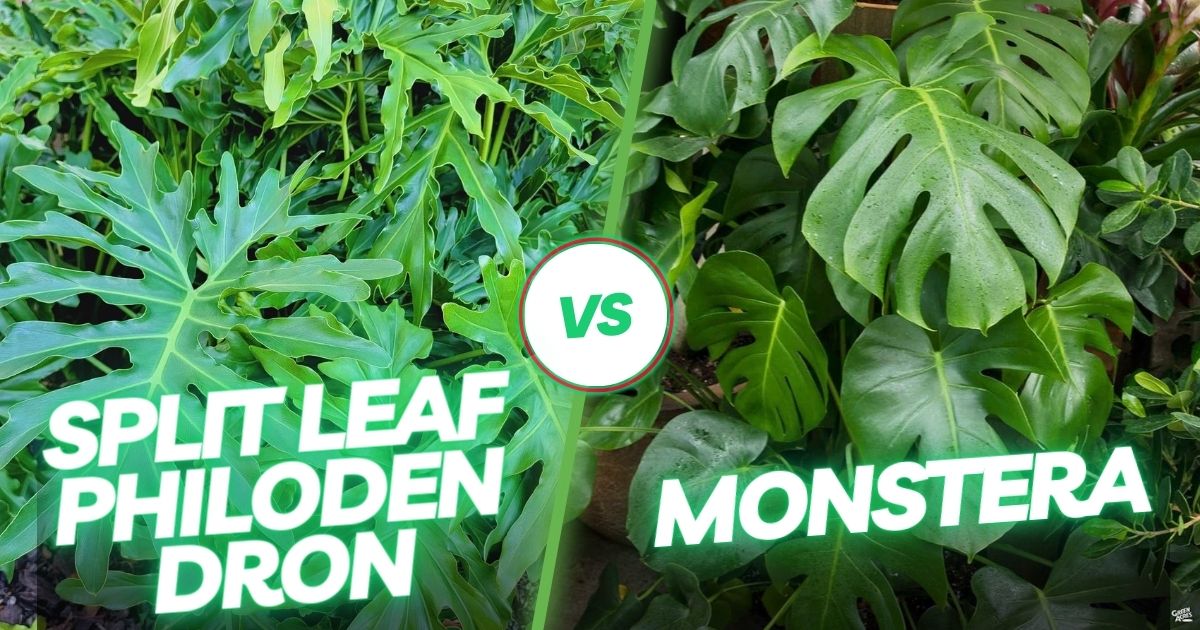In the green world of houseplants, Split Leaf Philodendrons and Monsteras are popular plants, gracing many homes with their tropical allure. With their awesome looks and easy to care for, they’re top picks for plant lovers and newbies. But, behind their similar looks, they possess unique characteristics. Before you decide to integrate one of these green wonders into your living space, understanding these nuances is a big deal. Join us for a deep dive as we compare Split Leaf Philodendrons and Monsteras to show their looks, how they grow, care needs, and more. We want to get you ready to figure out which plant fits best with your dreams and way of life.
The Difference Between Split Leaf Philodendron vs Monstera Overview
| Characteristic | Split Leaf Philodendron | Monstera |
| Scientific Names | Philodendron bipinnatifidum | Monstera deliciosa |
| Appearance | Broad, fingered leaves with deep splits and lobes | Iconic split leaves with irregular perforations |
| Leaf Size | Up to 3 feet long but only around 1 foot wide | Up to 3 feet long and 2 feet wide |
| Texture and Shape | Smooth, deeply lobed | Glossy with distinct perforations |
| Toxicity | Toxic if consumed | Toxic if consumed (except ripe fruit) |
| Fruit | Does not produce fruit | Produces large, edible fruit when mature |
| Growth Habit | Fast growth, up to 15 feet, outward spread | Climbing, up to 10 feet or more, needs support |
| Care Requirements | Bright indirect light, moderate watering, 65-80°F | Bright indirect light, consistent moisture, 65-85°F |
What’s the Difference Between Monstera and Split-Leaf Philodendron?
Scientific Names
For those who dabble in the plant world or are just curious enthusiasts, understanding the scientific nomenclature of houseplants makes it cooler. So, both Split Leaf Philodendron and Monstera offer fascinating insights.
- Monstera: Also called Monstera deliciosa, this plant has always remained true to its genus classification. From Mexico, it’s known for its unique leaves and delicious fruit. Chúng falls under the Monstera genus và there are over 40 different kinds of this plant mà each with its own charm.
- Split Leaf Philodendron: Unlike what people call it, it’s not a true Philodendron. First, they put it in the Philodendron group, but recent plant research changed its group to the Thaumatophyllum group, so now it’s called Thaumatophyllum bipinnatifidum. This change happened after figuring out its traits matched more with other plants in the Thaumatophyllum group than Philodendrons. From the warm places of South America, especially Brazil, it brings the green vibe of its homeland into homes all over.
An interesting overlap is that both these plants belong to the Araceae family, which explains why they’re super similar. This extensive family encompasses a myriad of plants, including household favorites like peace lilies and the ever-versatile pothos. It’s no wonder that Monstera and Split Leaf Philodendron often get mixed up, but with this info, you’re now ready to tell apart these two green wonders.
Appearance
While the Split Leaf Philodendron and Monstera might seem strikingly similar to the untrained eye, discerning their unique characteristics can make identification straightforward. Let’s check out the cool differences that set these two fave houseplants apart.

Leaf Size and Shape:
Split Leaf plants usually have tinier leaves than Monsteras. Their leaves have deep lobes, often going right up to the middle of the leaf, giving them a fancy look. But, Monstera leaves are way bigger, with less and more shallow lobes, making the perforations appear more like holes than splits.
Leaf Texture:
The touch and sheen of their leaves present another contrast. The leaves of Split Leaf plants have a bit of a rough feel, often showing a wavy look. On the flip side, Monstera leaves are known for their shiny surface, making them pop under the right lights.
Fenestration and Splitting Patterns:
One of the standout traits of Monstera leaves is the holes in the leaves — making holes as the plant grows up. The exact reason for this unique adaptation remains a subject of intrigue, with theories ranging from protection against strong winds to maximizing light absorption in dense rainforests. As a result, older Monsteras tend to have leaves with more pronounced holes.
On the other hand, the leaves of Split Leaf plants look like “leafy fingers“, but they never really get holes. No matter how old they get, the gaps in these leaves are just the gaps between these cuts.
Leaf Size
Both Monsteras and Split Leaf Philodendrons give a hint of jungle to homes with their big leaves. However, there’s a notable difference in the expanse of their foliage. Let’s dig in to understand the size and features of their leaves.
- Monstera Leaves: Monsteras are often the centerpiece of botanical conversations because of their super big leaves. They can easily boast leaves stretching to about three feet in length and two feet in width. These measurements are especially true for mature plants, approximately three years or older. While younger Monsteras start off with petite leaves, they rapidly expand in size as the plant grows. However, for indoor Monsteras, owing to controlled environmental conditions, the leaves might not reach their biggest possible size but are still the main attraction in any room.
- Split Leaf Philodendron Leaves: On the other side, Split Leaf Philodendrons, while still producing sizeable leaves, tend to be more reserved compared to Monsteras. They can achieve lengths of up to 3 feet but are generally narrower in design, with widths typically measuring around one foot. The elegance of these leaves complements many interior styles, offering a less domineering yet equally captivating presence.
Environmental Impact on Leaf Size: It’s important to know that the environment has a big role in how these plants grow. For example, Monsteras in not-so-great light might not have their classic big leaves. Similarly, the size of Split Leaf Philodendron leaves can be affected by their surroundings.
Toxicity
Both Monstera and Split Leaf Philodendron are dressed up with breathtaking leaves that make them a delightful addition to many interiors. However, it’s super important to be informed about one shared characteristic that warrants caution: their toxicity.

Toxicity in Both Plants:
Though they different in many aspects, Monsteras and Split Leaf Philodendrons are both in their toxic nature. Both plants contain compounds that can be harmful when ingested, and risky to both humans and pets.
Exception with Monstera Fruit:
While the leaves and stems of Monsteras are toxic, there’s a unique aspect to note. The fruit of the Monstera deliciosa, when fully ripened, you can eat and safe for consumption. However, it’s super importan to ensure it’s thoroughly ripe before considering it as a tropical treat, as the unripe fruit can cause irritation.
Safety Precautions:
Given their toxic nature, it’s of really importance to place these plants in areas out of reach to nosy pets and young children. Making sure they’re up high can stop accidental munch, safeguarding your household’s wellbeing.
Fruit
While both the Monstera and Split Leaf Plant hail from tropical places and are adored for their unique leaves, their fruit-bearing capabilities set them apart in an interesting way.
Monstera’s Fruitful Offering:
The fruit of the Monstera deliciosa is a cool look. This oblong berry, adorned with greenish-white scales, contrasts its formidable foliage. Inside this fascinating exterior lies a fleshy, white center which, when ripe, offers a delectable taste reminiscent of a blend between pineapples and bananas.

Yet, many aficionados of the Monstera plant might be unaware of its fruiting prowess, leading to the apt naming: Monstera deliciosa. A word of caution, though: the fruit should be consumed only when fully matured and ripe. The premature, unripe fruit contains compounds that can lead to mouth pain and other bad feelings upon ingestion.
Ripening the Monstera Fruit:
For those lucky enough to witness their Monstera produce this tropical treat, patience is the key. The fruit, which can measure an impressive 12 inches in length and 6 inches in width, needs to be left in a warm, sunlit area to mature. The clear signs of its ripeness are a yellow hue and a softened rind.
Split Leaf Philodendron’s Fruitless Nature:
In contrast, the Split Leaf Plant, while equally captivating in its awesome leaves, does not offer the joy of fruiting. This trait makes the Monstera’s fruit-bearing ability all the more special among indoor tropical plants.
Growth Habits
Both Monstera and Split Leaf Philodendron are cool tropical plants. Their big leaves turn any place into a green paradise. But when we delve deeper into their growth habits, we uncover distinct differences that set these two plants apart.
- The Expansive Growth of Split Leaf Philodendron: Although they share aesthetic similarities with the Monstera, the growth habits of the Split Leaf Philodendron are markedly unique. This plant showcases a vigorous growth rate, expanding both vertically and horizontally. It can cover a whopping 15 feet or more if you let it grow wild. That’s why they need repotting more than Monsteras. Unlike the climbing Monstera, Philodendrons display a more vining or trailing growth pattern.
- The Climbing Nature of Monstera: Monsteras, in their natural habitat, have evolved as climbers. Their inherent tendency is to ascend, seeking sunlight and anchoring themselves to taller structures. This climbing style is clear when you grow Monsteras at home. They usually need things like moss poles to grow well. They grow about two feet a year, which might seem slow next to Philodendrons’ four feet. But, Monsteras can still reach high heights, often over 10 feet.
Differences at a Glance:
- Speed & Size: Split Leaf Philodendron outpaces the Monstera in growth, often demanding frequent repotting. In terms of sheer size, they can span a remarkable 15 feet or more.
- Direction of Growth: While Philodendrons sprawl both upward and outward, Monsteras predominantly aim for the skies, ascending vertically.
- Support Requirement: Monsteras, being inherent climbers, will often need external support, like moss poles, to ensure they grow healthy and tall.
Care Requirements
- Check out the unique care routines for both Split Leaf Philodendrons and Monsteras. Sure, they have some things in common, but each plant needs some special care to really shine indoors.
Philodendron Care Essentials
- Watering: The key is moderation. Maintain soil that’s evenly moist, but not drenched. Water every 1-2 weeks in summer and not as much in winter, making sure the top bit of soil feels dry first. Consider self-watering planters if you’re often away.
- Soil Mix: A blend of well-drained soil, perlite, and sand forms the ideal foundation. Make it drain better and get some air flow using LECA balls. And yeah, make sure your pots have those drainage holes.
- Light: They like lots of light but not direct sun. Only a few hours of direct sun is okay. If leaves go yellow, it’s probably getting too much sun.
- Temperature: Keep the environment between 65-80°F. Shield the plant from locations where temperatures might plummet below 55°F.
- Fertilization: Fortify with a 20-20-20 fertilizer, diluted to half strength, bi-monthly in spring and summer, and monthly in winter.
- Pruning & Repotting: Trim to manage size and remove damaged leaves. For repotting, opt for a container just slightly bigger than the current one.

Monstera Care Essentials
- Light: Monsteras relish in bright, indirect light. Refrain from exposing them to direct sunlight for extended durations.
- Watering: Monsteras prefer consistent moisture without becoming waterlogged. A finger-test to gauge the top inch of soil’s dryness can guide your watering routine.
- Temperature: Being tropical, they prosper in warmth, ideally between 65-85°F, but can tolerate as low as 55°F.
- Fertilization: While not mandatory, Monsteras benefit from a half-strength balanced fertilizer once monthly during the active growing season.
- Pruning: Regular trimming rejuvenates Monsteras and spurs fresh growth. Snip off dead or unhealthy foliage while being cautious not to cut too close to the base.
Shared Care Highlights
Both Split Leaf Philodendrons and Monsteras:
- Favor bright, indirect light.
- Demand regulated watering to prevent monstera root rot.
- Thrive with periodic fertilization during the growing season.
Which Plant Is Right for You?
Deciding between the Split Leaf Philodendron and Monstera ultimately comes down to what you like, how much room you have, and thinking about safety around pets and children.
If a plant that grows super fast and a tropical ambiance is what you’re after, the Split Leaf Philodendron may be your best choice. Moreover, if you have pets or children, this plant may be a safer option, as how poisonous it is is generally considered to be less strong than that of the Monstera.
On the other hand, if you’re in the market for a standout plant with unique leaves and have how much room you have upwards, the Monstera can be a cool addition to your collection.
In the end, the best approach is to interact with both plants in person, gauging which one feels right for you the most, taking into account how it grows, looks, and cares needs.
For more information on split leaf philodendrons and monsteras, please visit the FamiPlants blog.

